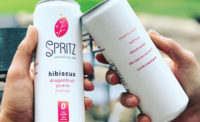![]()
Molson Succeeds in the U.S. brewing the Canadian way
By Jamie Popp
As the prime brewer of
Molson products for the U.S. market, Molson Inc.’s Montreal brewery
bottles and packages beer in everything from 12- and 24-packs to the
5-liter keg. With the flexibility to handle special graphic packaging such
as the goalie-mask can and multiple versions of twin labels, the brewery is
a key component in Molson USA’s success.
The company is particularly proud of its continued success with
the 5-liter keg, according to Benoit Maillette, director of packaging and warehouse.
“[Producing the 5-liter keg] is a very particular operation, it’s very sensitive
and you have to pay close attention to quality. Many other producers have gone
out of production because of quality concerns [due to beer preservation issues].”
The line used to affix front and back labels to Molson
Canadian product for export also serves as a unique marketing feature that
is not common in North America. Maillette says the dual-label look is
popular among European consumers, which justifies the cost of adding a
second label. The initiative was introduced by Molson USA into the United
States market more than one year ago and has been well-received by American
consumers.
“It needs to be tied to marketing and sales
initiatives otherwise, from a production standpoint, there is no advantage
to putting more labels on your product. Less is better for cost
purposes,” Maillette says.
Marketing ideas that are generated in the United
States are introduced to the brewery team every week. Whether it’s a
new package or promotion, the marketing team at Molson USA is in close
contact with the brewery.
“What’s advantageous with a plant like this is… while the lines
are somewhat old, they can still give us a lot of flexibility,” Maillette says.
“We have the ability to remove or add product while still in the packaging process.
For example, we recently did a 28-pack with 24 Export and four Export Light.”
Packaging Flexibility
In addition to a good-tasting product, consumers want
beer to have the right look, according to Maillette. With consumers paying
more attention to package detail, Molson’s Montreal plant has an
important role as a packaging leader in the company’s business.
“All of our initiatives go through a Global Quality and Innovation
group,” Maillette says. “They prioritize our projects and make sure that we
do the feasibility analysis to make sure that when we introduce a new package
in the plan, it’s going to run well, keeping quality in mind.”
The attention to quality and cost effectiveness
doesn’t end with new packaging. The beer industry has decided to use
standard returnable bottles for most of its needs. Maillette says more than
90 percent of beer volume sold in Canada is sold in glass bottles. In
addition to advancing environmentally focused beer bottling, the brewery
worries about the product’s pristine shelf appearance. The brewery
monitors label application to ensure that each label is properly placed to
maintain a consistent quality appearance.
As a major brewer in Canada, Molson has flexible
relationships with its suppliers, and therefore carries little inventory.
Based on forecasting in the United States, the brewery produces only what
it needs to based on demand.
“If we’re going to launch something, [the U.S. sales forecast
tells us] what volume we’re going to require to fill the distribution pipeline,”
Maillette says. “Once we have the forecast, it serves as a production guideline,
yet we operate with enough flexibility to adapt to our customers’ lead-time.”
The brewery produces beer based on each order placed by Molson
USA. Through its agreement with Coors, the brewery ships its Molson brands across
the border, and Coors picks up and distributes the product.
“We want to provide our customer as fresh a beer as possible
so there is no lead-time,” Maillette says. “As soon as it’s produced, it’s shipped
to the United States. We don’t carry any inventory here.”
Product Integrity Guarantee
Molson Canada has taken quality control to a new level
by not only implementing programming to ensure a better beer, but to be the standard to which all other breweries in
the Molson network are measured. In the early 1990s, a process control
program began in the Montreal brewery and a training facility was
established.
“We have permanent employees working [in the training facility],”
Maillette says. “Everyone who is employed needs to be qualified to operate the
machines. They also are trained on process control.”
Training on process control involves everything from
following a brew sheet to quality control
checks. Having good process control is an integral part of a
product’s integrity, according to Maillette. This control ensures
that the cleaning stage, which is done with caustic solutions, does not
affect the quality of the product during processing.
“We’ve got very strict processes describing
how cleaning should be done and engineering standards on how the equipment
should be arranged to prevent any type of product contamination,” he
says.
With lab analysis and tasting done on site, each part
of the process is closely monitored. And although Canadian law does not
heavily regulate the process, it does pay close attention to sanitation and
alcohol content for excise purposes and safety.
“It’s really more of an industry standard to handle consumer
complaints and determine if it can be traced back to the brewery.” Maillette
says. “Every year, we have targets to reduce consumer complaints as much as
we can and we always introduce new features to the process control and new equipment
that will give us better quality. Equipment has improved over the years to detect
problems. That’s been a tremendous improvement.”
Quantity Breeds Quality
Molson’s Montreal location is a licensed brewer for a number
of large-scale companies in the brewing business. It currently has contracts
with Miller Brewing Co. in Milwaukee, Coors Brewing Co. in Golden, Colo., and
Foster’s in Australia.
“The interesting aspect of being a licensed brewer is that you
get auditors coming in saying that our beer needs to be produced in such a fashion’,”
Maillette says. “As you move from one company to another, you get a different
beer philosophy as far as how you approach process control and how you approach
quality. Knowing more or different approaches makes you aware of potential flaws
in your process control and basically gives you a wider-angle view of how you
should do things and how you can improve on the process.”
The exchange of information from brewer to brewer is a big part of improving the overall quality
of the beer industry, according to Maillette. One of the biggest
improvements he has seen has been oxygen control. However, not all brewers
freely share their tricks of the trade.
“North American breweries are very competitive and therefore
more protective of the way they do things,” Maillette says.
Brewing Basics
The three lines used for U.S.-bound product can produce 1,600
bottles per minute per line. The 110-valve filling equipment handles two bottle
sizes —355-ml. for the U.S. market and 341-ml., which is standard in Canada
— just by adjusting the crown, Maillette says. Regardless of the bottle size,
the thickness of the glass is important to prevent breakage on the line. Increasingly,
Molson is exporting part of its production in returnable glass bottles, which
contributes to saving costs.
Although the brewery was the first to produce Molson
beer when it opened in 1786 and has strong ties to its heritage, it
continues to expand and improve its operations. The brewery was refurbished
in 1990 to accommodate more volume. Touring the brewery’s four floors
is a trip through many eras of growth and development. Today it’s a
showcase of tried-and-true methods and modern tanks and processing
equipment.
Brewing operators handle their product inventory for the brewery,
and they are responsible for producing the wort that will be fed into the yeast
in order for the fermentation to take place.
“The brewhouse is where we do different Molson
brands with types of malts and hops,” Maillette says, putting on his
hat as a former brewmaster. The Montreal brewery produces ales and lagers
with malted barley from Western Canada. From grain receiving to wort
cooling, there are more than 2,000 control points in which a computer
monitors the entire brewing process. The challenge is to create a
consistent flavor from one brew to another, Maillette says.
Both an automated system and line operators are
involved in making sure that Molson beer meets quality requirements.
Automatic filters treat beer, adjust alcohol content and carbon dioxide
levels, and operators test the finished product for clarity and other parameters.
“This portion of brewing needs to be as flexible as possible,”
Maillette says.
Saskatchewan Barley: Love in a Bottle?
It seems like a stretch to promote beer as an aphrodisiac, but
that hasn’t stopped Molson USA from investigating the possibilities. Recent
efforts to market Molson beer made with Saskatchewan barley to a U.S. audience
has uncovered a remarkable inherent quality. Combining the expertise of a brewmaster
at Molson’s Vancouver brewery and a creative marketing team has resulted in
a new advertising campaign for Molson USA.
“We pride ourselves in quality beer,” says Steve Breen, vice
president of marketing at Molson USA. “We’ve been using the finest hops since
we began brewing beer, but consumers were not that interested. One of our creative
guys went up and met with one of our brewmasters to find out what makes Molson
beer special, what makes it really drinkable and a great tasting import.”
From that discussion, it was discovered that
Saskatchewan barley is high in zinc, which is also found in aphrodisiacs
such as oysters and truffles. And although the company and barley growers
won’t deny that Molson beer offers consumers a chance to enhance
their relationships, they also won’t admit the connection is anything
but psychological. Whatever the case, it’s a fresh look at a beer
with centuries of history and a new consumer base to entice.
“It’s neat seeing our creative guys meet
with brewmasters, take the facts and make them relevant to a younger
drinking age guy,” Breen says.



